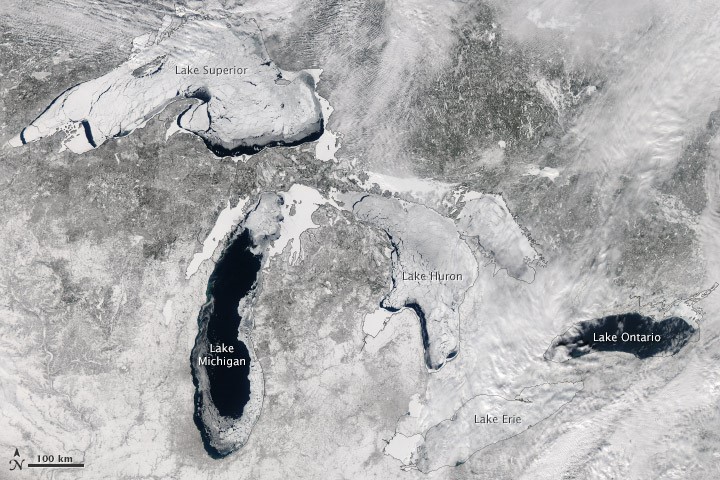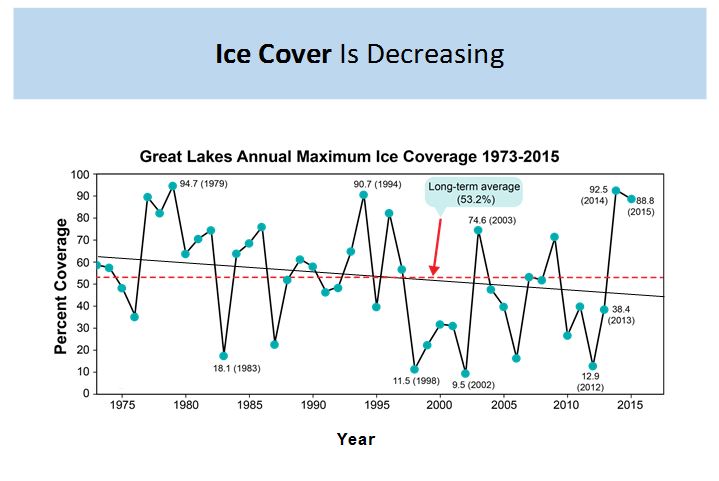
Climate change is expected to impact locations across the globe, including the Great Lakes. Experts say warmer temperatures, more severe spring storms and reduced ice cover will make it easier for harmful algal blooms to grow and remain in lake waters. What’s more, it seems that winter isn’t putting a brake on algal growth in Lake Erie – just changing the type of algae.
Globally, this year is on track to be the warmest on record. Last year, the Great Lakes experienced a warmer and drier winter than usual thanks to the El Niño effect from the Pacific Ocean. That warmth kept ice cover low on the Great Lakes, and thanks to a relatively dry spring the 2016 algal bloom on Lake Erie was much smaller than in recent years. But are these trends or simply outliers? It’s complicated.
Common sense would suggest that as the Great Lakes climate warms up, ice cover would be reduced. There are other factors too, according to Jia Wang, ice climatologist for the National Oceanic and Atmospheric Administration (NOAA) in Ann Arbor, Michigan. The major player is the jet stream encircling the globe in the northern latitudes. As the jet stream fluctuates, colder and warmer air moves around to follow it. In some years, like the winters of 2013-14 and 2014-15, the jet stream’s shape drags frigid arctic air from Alaska and Canada southeastward, leading to colder temperatures and thus greater ice cover on the Great Lakes.
Wang said data on ice cover for the Great Lakes only goes back to 1973, but there appears to be a cycle showing increasingly reduced ice cover into the ‘90s before a rebound in the 2010s. Based on the data, the basin lost 26 percent of its maximum ice cover from 1973 through 2015, with Lake Superior losing the most – about 39 percent. Cold winters starting in 2013 and 2014 brought ice cover to levels seen in the late 1970s, though.

Environment and Climate Change Canada (ECCC) Research Manager Ram Yerubandi says lake water temperatures have been increasing, according to decades of available data. Less ice cover in the winter means the lakes could see increased evaporation, which in turn would reduce water levels. Climate change models for the Great Lakes are split on whether the region could see decreased water levels. Models show increased precipitation, particularly through more spring storms which could mean more nutrient runoff for harmful algal blooms to feast upon in the summer.
Warmer Temperatures and Less Ice Could Strengthen Algal Blooms
Less ice cover could bring a host of other changes to the Great Lakes ecosystem. Arthur Zastepa, research scientist with ECCC, said there are algae called diatoms that bloom during the winter in Lake Erie. These brown algae form their blooms under the ice and in cracks, attaching themselves to it so they can grow.
“Life is thriving out there in the winter time,” Zastepa said. “However, we don’t quite understand the link between wintertime production and the effect it has on hypoxia (low-oxygen conditions) and algal blooms in the summertime and the mechanisms responsible.”
Zastepa said scientists are still trying to understand what happens to these blooms when the spring hits, though recent investigations suggest that they settle into the sediment and begin to break down when temperatures rise, contributing to hypoxia
.

Brown algae isn’t as bad as the blue-green variety known as cyanobacteria, which can produce toxins associated with harmful algal blooms. After nutrient-rich runoff enters the water system in the spring, blue-green algae can explode into blooms in July that last into October.
This year, while the larger bloom in Lake Erie had broken up by October, patches of it were still growing well into the latter part of that month. Zastepa said a warmer fall could be keeping those warm water-loving cyanobacteria going. Scientists are looking for these blooms earlier and later in their “growing season.” A dry summer also could play a role. If major rain events drive a lot of nutrients into Lake Erie in the spring and are then followed by a drought keeping the water column stable and stagnant, those potentially toxic cyanobacteria can thrive. While forecasts for 2017 only go through February, the US Climate Prediction Center expects wetter weather in the Great Lakes region during that period.

Heavier Spring Rains Could Provide More Food for Algae
There are additional climate impacts, and scientists are still trying to find out how they are connected to each other. Timothy Davis, a NOAA research scientist, said more spring rainfall in the region due to climate change could mean more nutrients entering the lakes and increase the overall flow from tributaries into the lakes. More rainfall also increases the likelihood of sediment washing into the lakes, reducing the amount of light getting into the water – which in turn could impact how summer blooms form and how toxic they become.
There are studies suggesting the most dominant blooming form (and potentially toxic) cyanobacteria microcystis produces more toxins at higher water temperatures and in a more nutrient-rich environment. Those same higher water temperatures could negatively impact invasive mussel species in the Great Lakes, whose filter-feeding methods further reduce competition for microcystis. There also haven’t been any studies completed on how climate change would impact the ability of the United States and Canada to achieve 40 percent nutrient loading reductions into Lake Erie, Davis said. Those unknowns make it hard for models to predict what could happen in the future in terms of bloom size and intensity, he said.
Climate change occurs on a decadal time scale and experiments take place on significantly shorter scales. Davis says climate models have a hard time making regional predictions on what will happen in the future with the Great Lakes, though trends suggest it will be hotter and generally drier, punctuated with severe storms.

Kevin Bunch is a writer-communications specialist at the IJC’s US Section office in Washington, D.C.




